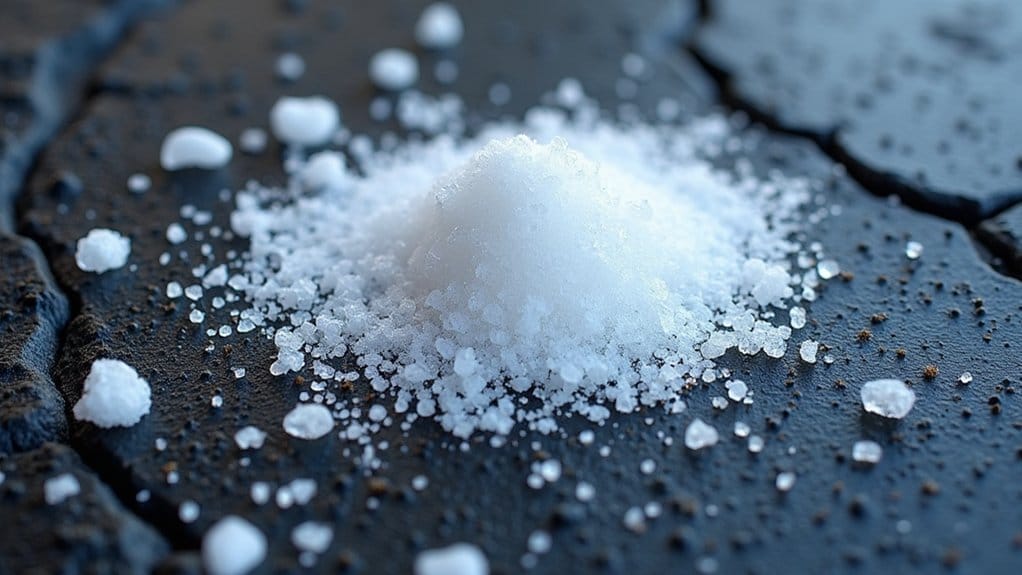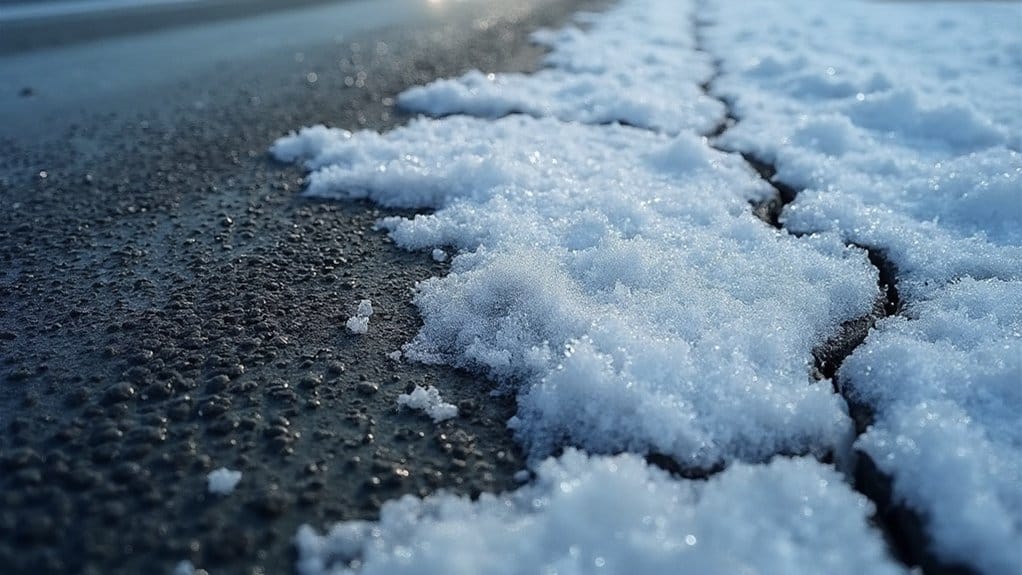De-icers are essential for winter safety but they’ll take a toll on your asphalt’s health! These chemicals cause brittleness and reduce your pavement’s ability to handle stress.
You’ll see up to 49% increased stiffness with certain acetate de-icers. Salt concentrations above 3% speed up deterioration during freeze-thaw cycles.
The good news? You’ve got options! Liquid de-icers work best before freezing conditions while granular types tackle existing ice. Smart application timing and proper maintenance can dramatically extend your asphalt’s life.
Let’s examine how you can protect your pavement investment while keeping winter surfaces safe.
Key Takeaways
- De-icers prevent ice formation but can cause asphalt brittleness and reduce stress-handling capabilities, particularly with sodium chloride-based products.
- Salt concentrations above 3% accelerate asphalt deterioration during freeze-thaw cycles, leading to significant cracking and structural damage.
- Oxidative aging from de-icer use increases asphalt brittleness by creating polar functional groups that enhance stiffness and viscosity.
- Liquid de-icers should be applied strategically before freezing conditions, with careful monitoring and reapplication to minimize asphalt damage.
- Regular sealcoating and proper maintenance can help protect asphalt from chemical interactions and extend pavement longevity despite de-icer use.
De-Icer Types and Properties

Various de-icers fall into two main categories: liquid and granular formulations.
You’ll find each type offers unique benefits for winter maintenance and safety. Let’s investigate their properties!
Liquid De-Icers – Your Pre-Treatment Champions
- These powerful solutions dissolve in water to prevent ice formation.
- You can apply them before snowfall hits the pavement.
- They’re fantastic for concrete, brick, asphalt, and wood surfaces.
- Key players include rock salt, magnesium chloride, and calcium chloride.
Granular De-Icers – Your Heavy-Duty Warriors
- Perfect for spreading across already-icy surfaces.
- They work by breaking down ice as they dissolve.
- You’ll love their easy storage and handling.
- Great for large-scale applications where frequent reapplication isn’t practical.
Chemical Magic at Work
The science behind these de-icers is fascinating! Liquid deicers can effectively melt two inches of snow during active precipitation.
When you apply them, they create a freezing point depression. This means water can’t form ice at its usual 32°F (0°C).
Sodium chloride releases ions that disrupt ice formation, while potassium formate actively breaks down existing ice.
Remember: Both liquid and granular de-icers can be corrosive, so you’ll want to choose wisely based on your specific needs!
Low-Temperature Performance Challenges
Ever wonder why your asphalt pavement becomes more brittle during winter? It’s a fascinating process that’s directly linked to de-icing agents and temperature changes!
When you apply de-icers to your pavement, they cause considerable changes in your asphalt’s ability to handle stress. Traditional de-icers like sodium chloride causes corrosion and significant cracking in pavements. Regular maintenance services, including seal coating, can help mitigate some of the damage caused by these harsh chemicals.
The numbers tell an eye-opening story. After soaking in common de-icing solutions, asphalt’s creep stiffness increases dramatically. We’re talking about increases of up to 49% with certain acetate de-icers! This means your pavement becomes less flexible and more prone to cracking.
Here’s what you’ll notice about brittle behavior and freeze-thaw cycles:
- Acetate-based de-icers cause more damage than chloride-based ones
- Higher concentrations of de-icers lead to more severe deterioration
- Your pavement’s stress relaxation ability decreases considerably
- Creep rates can drop by up to 6%, making the asphalt less adaptable
Think of your asphalt like a rubber band – it needs flexibility to survive winter conditions. De-icers make it more like a rigid stick, ready to snap under pressure.
The higher the concentration of de-icers you use, the more dramatic these effects become!
High-Temperature Stability Effects

While winter brittleness poses significant challenges, de-icers actually show surprising benefits during warmer months. Salt concentrations above three percent accelerate deterioration under repeated freeze-thaw exposure. You’ll be amazed to learn that certain de-icers can improve your asphalt’s high temperature performance! They work by increasing the anti-rutting factor and reducing phase angles.
Let’s break down the exciting benefits:
- De-icers like NW056 and KHF-1A outperform traditional NaCl
- They’ll make your pavement more resistant to deformation
- You’re getting better stability at high temperatures
Here’s what’s happening beneath the surface: De-icer ions penetrate the asphalt and create fascinating chemical interactions. They’re actually reducing light components and changing molecular bonds. It’s like giving your pavement a protective shield!
The best part? Acetate-based de-icers are your premium choice. You’ll find they:
- Work more effectively than chloride-based options
- Show more consistent performance across temperature ranges
- Increase creep stiffness while reducing creep rate
But there’s a trade-off you should know about. While you’re getting better high-temperature stability, you might see some reduction in fatigue performance. It’s all about finding the right balance for your specific needs!
Chemical Reactions in Asphalt
Understanding the complex chemical reactions in asphalt is essential because they directly affect your pavement’s durability and performance. When asphalt’s exposed to air, oxidative aging kicks in. This process alters your pavement’s chemical makeup through molecular interaction between different components.
You’ll see major changes happening as oxygen interacts with your asphalt’s components. These alterations aren’t your friend! They’re making your pavement harder and more brittle over time.
Here’s what’s really happening inside your asphalt:
- Oxygen creates polar functional groups that increase asphalt’s stiffness
- Nonpolar components change into polar ones, enhancing viscosity
- Ketones form during oxidation, leading to significant hardening
- Asphaltene fractions become more concentrated, affecting flexibility
The chemical dance between components doesn’t stop there! Your asphalt’s molecular structure keeps changing through various interactions.
Think of it like a slow-motion alteration where molecules are constantly rearranging themselves. These changes directly impact how your pavement performs and how long it’ll last.
That’s why understanding these reactions helps you make better decisions about maintenance and preservation! Regular sealcoating can significantly extend the lifespan of your asphalt by protecting it from these detrimental chemical interactions.
Environmental Impact Assessment
Chemical reactions in asphalt aren’t the only concern when it comes to pavement maintenance – de-icing agents pose significant environmental risks you need to take into account.
Let’s explore a quick environmental assessment of these impacts:
Water and Soil Effects
- You’ll find 30% of applied salt heading straight to major water bodies
- The remaining 70% doesn’t just disappear – it seeps into groundwater or stays in soil
- Chloride-based de-icers are especially troublesome because they won’t break down
Air Quality Concerns
- Your de-icing activities create 10 times more dust than you might expect
- Urban areas frequently exceed safe PM10 particle levels
- This affects both human health and plant life
Impact Evaluation Shows Widespread Effects
- Roadside vegetation takes a direct hit from chemical exposure
- Wildlife and aquatic ecosystems struggle with high chloride levels
- Small water bodies are particularly vulnerable
The good news? You’ve got options! Consider:
- Anti-icing strategies to reduce salt use
- Self-ice-melting asphalt technology
- Green infrastructure solutions like permeable pavements
Remember: Every environmental impact you prevent today helps protect resources for tomorrow!
Application Methods and Timing
In accordance with proper de-icing practices, the timing and method of application play vital roles in maintaining safe surfaces during winter conditions. Your application techniques must be precise and strategic to maximize effectiveness.
You’ll want to start treating surfaces as soon as snow begins to accumulate. This proactive approach prevents thick ice layers from forming.
For successful timing strategies, consider these significant points:
- Apply liquid de-icers up to 3 hours before expected freezing conditions
- Use pre-wetted solid salt 1-2 hours before a winter weather event
- Monitor surfaces every 15-30 minutes after initial application
- Reapply if needed when surfaces become wet or ice forms
You’ll achieve the best results by spreading de-icers in a thin, even layer. Focus on high-traffic areas first!
When using liquid solutions, opt for a sprayer to guarantee uniform coverage. For solid materials, pre-wet them to improve their staying power on the surface.
Don’t forget to combine your de-icing efforts with manual snow removal. This energetic duo creates the most effective winter maintenance strategy.
Keep monitoring conditions throughout the storm event – it’s your key to success! Additionally, regular maintenance, including timely de-icing, can help extend driveway lifespan and prevent costly repairs.
Prevention and Maintenance Strategies

Protecting your asphalt from winter damage calls for a balanced approach between effective de-icing and surface preservation. You’ll need smart preventive measures to keep your pavement strong through harsh winters.
Key Maintenance Techniques
- Remove snow mechanically before applying any chemicals
- Target de-icer application to high-traffic areas only
- Monitor pavement conditions daily
- Fix cracks and drainage issues before winter hits
Smart Application Strategies
You don’t need excessive amounts of de-icer! Apply just enough to break the ice-pavement bond. Wait for it to work before adding more. You’ll save money and protect your surface.
Advanced Protection Methods
Consider these exciting innovations:
- Install heating mats in critical areas
- Use super-hydrophobic surface treatments
- Investigate microwave heating systems
Year-Round Care
Your preventive maintenance shouldn’t stop when winter ends:
- Rinse surfaces thoroughly in spring
- Repair winter damage promptly
- Reseal annually to strengthen protection
- Maintain proper drainage systems
Remember: Every dollar spent on prevention saves $5 in repairs. Your asphalt’s longevity depends on your maintenance dedication! Additionally, employing regular seal coating services can further enhance your asphalt’s durability against harsh weather conditions.
Self-Ice-Melting Technology Advancements
While traditional maintenance methods remain beneficial, revolutionary self-ice-melting technologies have emerged to reshape winter pavement protection. You’ll find extraordinary advancements in self ice melting materials that can revolutionize how we handle winter road maintenance. These innovative solutions offer exciting possibilities for safer winter travel!
Phase change technology stands out as a game-changing development. You can expect impressive performance from phase-change concrete. It maintains surface temperatures between 42°F and 55°F for up to 10 hours in freezing conditions. That’s powerful protection!
Here are the key benefits you’ll get from these advanced technologies:
- Self-heating concrete can melt snow at 0.25 inches per hour
- Phase-change materials enhance concrete’s freeze-thaw durability
- De-icing agents can improve immediate snow removal capabilities
- These systems require minimal maintenance intervention
You should know there are some limitations to keep in mind. Heavy snow accumulation over two inches can reduce effectiveness. The materials need time to recharge between freeze-thaw cycles.
But don’t let that discourage you! These technologies represent a significant leap forward in winter road management. They’re becoming more efficient and cost-effective with each new development.
Weather Pattern Considerations

Weather patterns dramatically influence how de-icing chemicals interact with asphalt surfaces throughout the year. Your pavement faces constant challenges from weather variability! High temperatures cause softening and oxidation. Freezing conditions trigger expansion and cracking. It’s a never-ending battle.
Temperature Extremes Matter
You’ll notice asphalt becomes softer in summer heat. This leads to rutting and deformation. UV rays speed up oxidation, causing your pavement to become brittle and fade. Climate adaptation strategies are essential for protection!
Freeze-Thaw Cycles Pack a Punch
Your biggest enemy? Water that freezes and expands in tiny cracks. When temperatures fluctuate between freezing and thawing, these cycles create devastating potholes. De-icers complicate this process even more.
Water: Friend or Foe?
Rain might seem harmless, but it’s not! Without proper drainage, water seeps into cracks and weakens your pavement structure. Add de-icing chemicals to the mix, and you’ve got a recipe for accelerated erosion. Regular maintenance, such as seal coating to protect against environmental damage, is crucial for extending the life of your asphalt.
The solution? Regular maintenance and smart de-icer application strategies. Your pavement’s longevity depends on how well you adapt to these weather challenges!
Long-Term Durability Factors
Beyond weather’s immediate effects, your asphalt’s lifespan depends on several structural and material factors working together. Installation quality plays a huge role!
You’ll get the best results when skilled contractors use premium materials and follow proper installation procedures. The right pavement thickness and stable base conditions are absolutely essential for long-term success.
Your asphalt faces different challenges depending on traffic loads and usage patterns. Heavy vehicles and high traffic volumes will accelerate wear and tear.
That’s why maintenance frequency needs to match your pavement’s specific needs. Regular sealcoating, crack repairs, and pothole fixes aren’t optional – they’re critical investments in your asphalt’s future!
Here are the key factors that’ll determine your pavement’s durability:
- A properly compacted base layer that provides excellent drainage
- Adequate pavement thickness designed for your specific traffic loads
- High-quality materials and expert installation techniques
- Consistent maintenance schedule with timely repairs
Remember: Your asphalt’s lifespan isn’t just about what you see on the surface.
It’s the combination of proper installation, material quality, and ongoing maintenance that creates a durable, long-lasting pavement solution. Don’t skip the essentials! Additionally, expertise in asphalt repair can significantly enhance the longevity of your pavement.
Conclusion
You might think de-icers are just a winter necessity, but they’re reshaping the future of road maintenance! Your roads will last 25-35% longer when you choose the right de-icing strategy. Don’t let skeptics tell you it’s too expensive – modern solutions like calcium magnesium acetate cost more upfront but save $47,000 per mile in long-term repairs. Start protecting your asphalt investment today with smarter de-icing choices. Your future self will thank you!
Protect Your Investment in Central PA
Winter maintenance is crucial for the health of your asphalt! De-icers can lead to brittleness and cracking if not managed properly. At Nathan Paving, we provide comprehensive services designed specifically to counteract these winter effects and extend your pavement’s lifespan with professional sealcoating and maintenance strategies.
Whether you need driveway extensions or asphalt repairs, our expert team is here to help. Get in touch with us for a free quote and ensure your asphalt investment stands strong against winter’s harshness. Get your free quote today!



